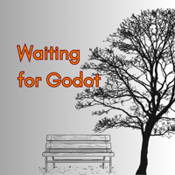
Overview
Synopsis
Two men, Vladimir (Didi) and Estragon (Gogo), meet near a tree. They while away the hours, talking philosophy, bodily functions, and sharing a few measly turnips, all while waiting for a man named Godot -- who never seems to come. They are joined by the oafish, bombastic Pozzo, his leashed human slave, Lucky, and eventually by a young boy, who informs them that that although Godot will not come today, he surely will tomorrow. In Samuel Beckett’s wickedly funny, frequently moving existential play, Didi and Gogo wait, and wait, and wait. Their plight and the desolate landscape they inhabit was inspired by Beckett’s experience during World War II, in which he spent many years in hiding as a member of a betrayed French Resistance group. Though tragic in theme and sweeping in scope, Waiting for Godot is a delectable combination of witty dialogue and physical comedy, and the roles have been embraced by actors such as Ian McKellen and Patrick Stewart, Robin Williams and Steve Martin, Nathan Lane and Bill Irwin, and many more. Waiting For Godot is theatre at its best -- surprising, charming, and compulsively watchable.
Show Information
Context
Following the end of World War II, many artists were grappling with the chaos and destruction of war, and looking for new modes in art and literature. In the late 1940s, Irish writer Samuel Beckett was living in Paris and wrote En attendant Godot, a symbolic investigation into the absurdity of life. It was originally broadcast on French radio in early 1952. It was then printed in September before its first theatrical performance in October at the Théâtre de Babylone in Paris. French critics
to read the context for Waiting for Godot and to unlock other amazing theatre resources!Plot
Act One
A blank landscape. A desolate road. A barren tree. Estragon, a vagabond tramp, is struggling to take off his boot. His friend Vladimir enters, and they greet each other. Estragon continues to pull at his boot while Vladimir examines his hat. In his examination, Vladimir becomes philosophical about the Gospels, and wonders why—in the telling of the Crucifixion—one of the Gospels is different regarding the account of the thieves. The men do not reach any conclusion except Estragon’s
to read the plot for Waiting for Godot and to unlock other amazing theatre resources!Characters
| Name | Part Size | Gender | Vocal Part |
|---|---|---|---|
|
Lead |
Male |
Non-singer |
|
|
Lead |
Male |
Non-singer |
|
|
Supporting |
Male |
Non-singer |
|
|
Featured |
Male |
Non-singer |
|
|
Featured |
Male |
Non-singer |
Songs
A song with an asterisk (*) before the title indicates a dance number; a character listed in a song with an asterisk (*) by the character's name indicates that the character exclusively serves as a dancer in this song, which is sung by other characters.
Monologues
Scenes
Key Terms
Absurdism is a 20th-century theatrical style that reflects the belief that life lacks inherent meaning. Playwrights such as Samuel Beckett and Eugène Ionesco used illogical dialogue, repetition, and surreal situations. The genre emphasizes the futility of human struggle and the breakdown of communication.
Refers to content that is obscure or difficult to understand, often found in avant-garde or symbolic theatre.
A philosophical movement emphasizing individual existence and responsibility, often reflected in modern theatre.
Innovative performance styles that challenge traditional theatre conventions.
A comedic character type, especially in English Renaissance plays, characterized by excessive concern with fashion and manners.
A theatrical style that emphasizes simplicity in staging and dialogue to focus attention on core themes and performance.
A character or theme reflecting a distrust or dislike of humanity, explored in comedic and philosophical dramas.
A system of thought exploring existence, ethics, or knowledge, often influencing theatrical movements like existentialism or realism.
A dramatic movement featuring illogical dialogue, cyclical plots, and existential themes, reflecting the absurdity of human existence.
A genre blending elements of tragedy and comedy, often leaving audiences in emotional or thematic tension.
Videos
Quizzes
Themes, Symbols & Motifs
THEMES
__The Absurdity and Meaninglessness of
to read about the themes, symbols and motifs from Waiting for Godot and to unlock other amazing theatre resources!Quote Analysis
"Nothing to be done."
(Estragon, Act One)
This
to read our analysis of select quotes from Waiting for Godot and to unlock other amazing theatre resources!
